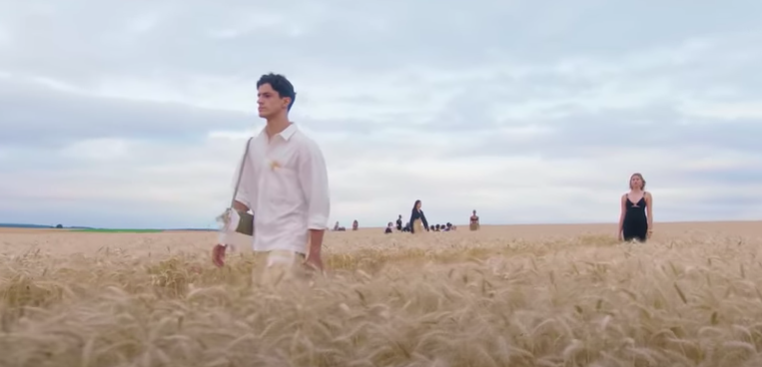While most of the world is accustomed to watching fashion shows through a screen, that’s usually not the case for designers, the press, buyers and influencers. But because of COVID-19, many fashion houses have forfeited their in-person runway shows in favor of creative digital presentations — Maison Margiela, Rick Owens, Gucci and Dior, to name a few. And yet, some brands couldn’t let go of the conventional model, even during a pandemic.
As much as I love Simon Porte Jacquemus and his mononymous brand, this week he and other designers disappointed me and many others in the fashion community by holding live shows.
Before his recent show, Porte Jacquemus said he wanted his collection to convey love and celebration “like a simple country wedding or a harvest festival.’” He named it “L’Amour.”
When elaborating about the show’s medium, Porte Jacquemus said, “For me, the runway can’t be a video. It’s at the heart of what we do; it’s not superficial. It’s important to all of us to continue, just like a restaurant that reopens. It’s like a movie of a summer day. It’s our life.”
Guests sat socially distanced in a large yellow field, while models walked through the winding pathway in front of them.
Other brands, such as Etro and Dolce & Gabbana, held live shows in Italy. Both brands’ guests were socially distanced and wearing masks, and Dolce & Gabbana’s guests were also temperature-checked.
The latter previously held a virtual fashion show in June, but Domenico Dolce and Stefano Gabbana weren’t happy with the result. “The fashion show cannot be substituted with something on a screen. You need the physical contact, the human connection. Because fashion begins with people,” said Dolce.
Gabbana agreed that virtual shows weren’t the same. “It lost its essence,” he said.
They held their most recent show at a medical school, Humanitas University, and had a virologist in attendance. One side of the building facing the show read, “EVERYTHING IS GOING TO BE ALRIGHT.” Professor Alberto Mantovani, scientific director of the school’s Clinical and Research Center, ended the show with, “The message I would like to leave you with is that the quest for biomedical innovation and the quest for creativity and beauty should fly together hand in hand in the service of health, education and humanity.”
[Halle Berry’s apology isn’t enough]
The existence of these shows right now seems quite dystopian. While it sounds extreme, we are somewhat living in a dystopia. According to Johns Hopkins’ Coronavirus Research Center, there have been more than 14.7 million confirmed cases of COVID-19 in the world, and more than 609,000 deaths. Dr. Anthony Fauci has talked of the looming second wave of the virus. Everyone is standing far away from each other in public, giving glances at others and wearing masks. None of this is normal.
And to hold a fashion show — whether or not guests are following safety protocols — is selfish and obsolete. We are at a point in society where the advancement of technology is constantly outdoing itself, and brands of this caliber have the budgets to make creative online shows displaying their designs.
While fashion is important to social, cultural and political landscapes across the world, there is no reason that Jacquemus, Etro, Dolce & Gabbana and other designers could not have gotten their point across through a different medium. Dior had a beautiful, fantastical short film showcasing their haute couture looks, where models intertwined with nature were shown miniature versions of their gowns before appearing in the full-sized ones. From the makeup to the set design, every aspect was as engaging as a regular show.
None of the models in these in-person shows wore masks, and none of the designers did, either. How are they supposed to set an example as vanguards of an industry if they can’t even follow basic safety protocol?
[Celebrities traveling during the pandemic are just as bad as anyone else]
While Dolce & Gabbana specifically have landed themselves in countless controversies in the past couple of years, one cannot deny the influence that such big brands have on the industry. When Porte Jacquemus broke the internet with his Le Chiquito mini bags, other brands followed suit by releasing dupes. These large brands set the precedent, and holding live, in-person shows probably makes other houses think they can do the same. The safety of everyone is more important than being at a live show.
There are so many risks involved with hosting such a show at this time. It would be almost impossible for models not to be face-to-face with makeup artists, hair stylists and countless others backstage making sure they are ready to walk. While guests are following guidelines to protect themselves, danger still lies in their transportation. Did they carpool in a ride-share used by other passengers on the same day to get to the show? Not all of the guests were based in Europe, so many flew in, and airports are a cesspool for germs. How do we know that one or more of the guests aren’t asymptomatic or weren’t in contact with a carrier?
The zest of an in-person fashion show would not be lost if brands switched to digital. They should adapt to the times and explore new horizons. Maybe in doing so, they would find new ways to truly innovate the way we view fashion.



